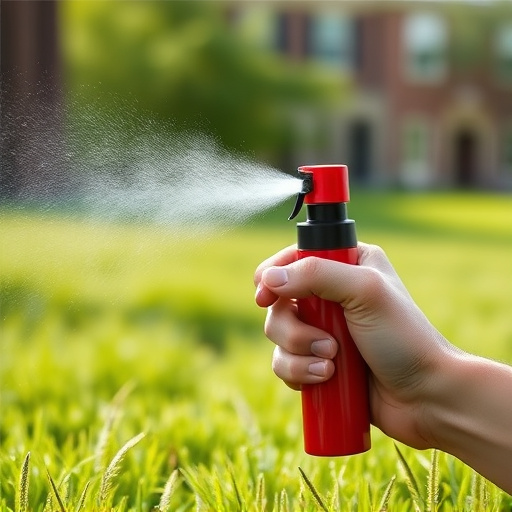Understanding when and how to safely use pepper spray involves knowledge of local laws, proper handling, responsible deployment, and training. It's a powerful self-defense tool for imminent threats, temporarily disabling aggressors for 2–5 minutes, but should be used as a last resort with caution to avoid unnecessary harm.
“Uncover the power of maximum strength pepper spray as a self-defense tool, exploring its active ingredients and potent effects. From understanding legal boundaries on carrying pepper spray to mastering safe handling and storage techniques, this comprehensive guide ensures effectiveness. Learn strategic self-defense moves to deploy pepper spray successfully in real scenarios, adhering to legal considerations for when and where it’s permitted. Discover the best practices for maximum strength pepper spray defense.”
- Understanding Pepper Spray: Active Ingredients & Effects
- Legal Considerations: When is it Legal to Carry?
- Safe Handling & Storage Techniques for Maximum Effectiveness
- Self-Defense Strategies: Effective Use in Real Scenarios
Understanding Pepper Spray: Active Ingredients & Effects
Pepper spray, a powerful self-defense tool, contains capsaicin, the active ingredient derived from chili peppers. This compound irritates the eyes, nose, and respiratory system, temporarily disabling an aggressor. The effects typically last 2–5 minutes, providing users with crucial time to escape or de-escalate a situation.
When used safely and responsibly, pepper spray can be a game-changer in potential assault scenarios. It’s essential to understand that it should only be deployed as a last resort when facing an imminent threat. Users must be trained to identify appropriate use cases, ensuring they are aware of local laws and regulations regarding its carrying and usage.
Legal Considerations: When is it Legal to Carry?
Knowing when to use pepper spray safely is crucial, but it’s also important to understand the legal considerations surrounding its carrying and usage. The legality of possessing and using pepper spray varies greatly from one jurisdiction to another, with some regions having strict restrictions and others allowing its use for self-defense under certain conditions.
In general, you can legally carry pepper spray if you reside in an area where it’s permitted by local laws and regulations. Some places require a permit or special training to obtain pepper spray, while others may restrict its type, capacity, or the circumstances under which it can be used. Always check your state’s and local municipality’s laws to understand the specific rules regarding when to use pepper spray safely without breaking any legal boundaries.
Safe Handling & Storage Techniques for Maximum Effectiveness
Proper handling and storage are crucial for ensuring that pepper spray remains effective when you need it most. To maximize its potency, keep pepper spray out of direct sunlight and extreme temperatures. Extreme heat can degrade the active ingredients, while cold can solidify the solution, making it less accessible. Store it in a cool, dry place, like a locked cabinet or safe, to maintain optimal performance.
When using pepper spray safely, remember that it’s intended for self-defense against close range assailants. Avoid spraying in windy conditions as the spray could blow back onto you. Only use it when absolutely necessary and be aware of local laws regarding its carry and use. Regularly inspect the spray to ensure there are no signs of damage or leakage and replace it before its expiration date for consistent effectiveness.
Self-Defense Strategies: Effective Use in Real Scenarios
In real-life scenarios, pepper spray can be a powerful tool for self-defense when used safely and appropriately. It’s crucial to understand that pepper spray is designed to temporarily incapacitate an assailant by causing irritation, pain, and reduced visibility. Therefore, it should only be employed as a last resort when facing an imminent threat of physical harm. The key to effective use lies in proper timing and awareness. Users must be alert and sense the right moment to deploy the spray, ensuring they are at a safe distance from the attacker while aiming for their eyes—the most sensitive target area.
Training and practice are essential to mastering the safe application of pepper spray. Individuals should learn the right techniques, including how to hold and activate the device correctly, to maximize its effectiveness without causing unnecessary harm to bystanders or the user themselves. When used judiciously, pepper spray can provide a crucial window of opportunity for escape and help deter potential attackers. Remember, self-defense is about taking control of a dangerous situation, and understanding when and how to use pepper spray safely is an integral part of that strategy.
Pepper spray can be a powerful tool for self-defense when used properly and within legal boundaries. By understanding its active ingredients, safe handling practices, legal restrictions, and effective deployment techniques, individuals can ensure they are prepared in potentially dangerous situations. Remember, while pepper spray offers a crucial moment of protection, it should only be employed as a last resort, and knowing when and how to use it safely is essential for maximum effectiveness.
